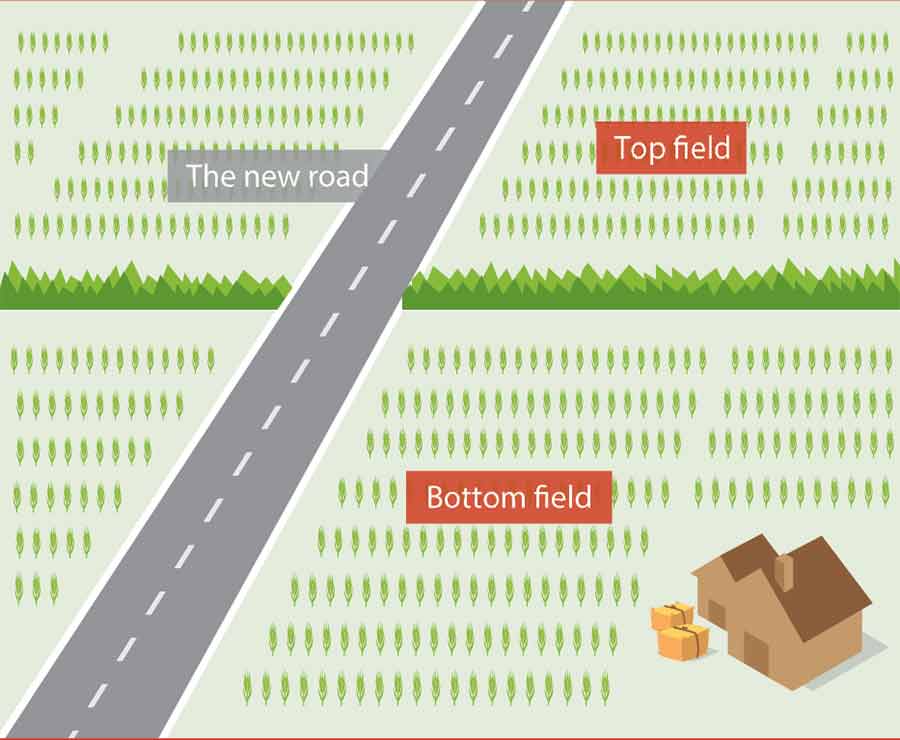Compulsory purchase of farmland: Claim what you are owed
 © Design Pics Inc/Rex/Shutterstock
© Design Pics Inc/Rex/Shutterstock The basic principle of compulsory purchase compensation is that the person affected should be returned to the same position after the event as they were in before.
The law, however, is very complex and it is sometimes difficult for money to fully compensate for what is lost.
It is therefore essential to take expert advice early in the process from a professional valuer with experience in this area.
See also: The farmers fighting compulsory purchase
It may be necessary to involve your solicitor and also your accountant, as tax advice might be needed. Professional fees can be included as part of the claim, subject to agreement with the acquirer.
What can you claim for?
 Kate Russell
Kate RussellTechnical and policy adviser, Central Association of Agricultural Valuers
Land taken
The landowner will be paid the open market value for the land taken, to build a road, for example.
Compensation for buildings and dwellings is considered as part of the “land taken” and their value is assessed on the basis of what they would fetch on the open market.
This can be an issue in relation to farm buildings, which often cost more to build than they would fetch if sold.
So where a farmer needs to replace a farm building that will be lost to the scheme, his valuer should seek to negotiate the replacement building as part of the compensation.
Compensation essentials
Appoint an experienced valuer as soon as you hear about the scheme – they can save you time, money and hassle.
Keep a diary to record all the time spent in dealing with the scheme, noting what happened, who was involved, how much time was spent and any expenses incurred.
Obtaining planning permission for a replacement farm building or dwelling is something the farmer will have to undertake themselves as the acquirer will not usually get involved.
The cost of obtaining planning consent is a legitimate part of the claim.
Where a dwelling is acquired, the occupier of the house (who may be the owner, a tenant or an employee) is entitled to a Home Loss payment in addition to compensation for the value of the property, provided they have lived in it for at least a year.
A homeowner or a tenant with a lease of more than three years will receive 10% of the value of the property or leasehold, with a minimum payment of £5,800 and a maximum of £58,000 in England (£5,500 and £55,000 in Wales).
Where land or buildings have development potential, the compensation paid should reflect the value on the open market at that date.
For example, land or a building with full planning permission will be worth considerably more than the same property that has “hope value”, but no formal consent in place.
If no land has been acquired, compensation is limited to physical effects such as noise, dust and vibrations from the use of the road/railway – there is no compensation for the loss of a picturesque view, well-being or the drop in value of a property that has not been directly affected by compulsory purchase.
Severance and injurious affection
This is the reduction in value of any remaining land. In the example below, Top field and Bottom field have been cut in two by a new road, leaving small parcels and severing the west side from the farm.
The parcels of land cut off from the farm yard may now be worth less than they were before, because the farmer faces greater operating costs to reach them.
The farmer can be compensated for that loss – this is the “severance” element.
The land left on the same side of the new road as the farm may also be worth less if the field parcels are smaller or in odd shapes. This is the “injurious affection” part of the claim.
Example: How to work out compensation

The amount of compensation for severance and injurious affection will often be assessed on a “before and after” basis.
Before new road built
- Top field was a 20-acre field worth £8,000/acre = £160,000
- 3 acres is taken for the new road @ £8,000/acre = £24,000
- Value remaining = £136,000
After new road built
- Top Field West is now a 5 acre paddock severed from the rest of the farm. Estimated value £5,000/acre = £25,000
- Top Field East is now a 12 acre field with an irregular shape. Estimated value £7,500/acre = £90,000
- Total value of remaining 17 acres = £115,000
- Difference between “before” and “after” valuation = £21,000
- The compensation in this case would be: Land taken = £24,000, severance and injurious affection = £21,000
- Total = £45,000 plus any disturbance compensation, loss payments and accommodation works
Disturbance
This includes other losses arising directly as a result of the scheme. For example, if the construction staff leave a gate open and livestock escape, the time spent in rounding up the livestock could be included as part of the disturbance claim.
Where a diversification business is part of a farm that has had land acquired, any losses that are directly attributable to the scheme should be compensated for as part of the disturbance element of the claim.
For example, if the contractors had to dig up the road leading to a farm shop and café and customers could not reach it for a week, the lost profits could be part of the compensation claim.
It is more difficult to obtain compensation if the property affected is situated near to the scheme, but no land has been acquired; the basis of compensation is different in such cases and requires another article to address it.
If a business such as a holiday cottage or wedding venue will not be viable after the scheme is built, then the owner can apply for compensation to extinguish the business. This sort of claim can be very contentious and complicated, involving valuations of the business and its profitability.
Loss payments
A landowner (and tenant) is entitled to a loss payment on top of other compensation, to reflect the fact that the purchase is compulsory.
In England and Wales the basic loss payment for landowners is 7.5% of the value of the claim, up to a maximum of £75,000 and the occupier’s loss payment is 2.5% of the value of the claim, up to a maximum of £25,000.
However, the law is to be changed to swap these figures around so the occupier receives the larger share. An owner-occupier gets both loss payments.
Making a claim
The initial claim can be made by the landowner when the acquirer serves formal notice, usually before entry is taken onto the land.
The initial claim will only be an estimate – it will be finalised when the works are completed. The acquirer will make an advance payment of 90% of their estimate of the claim at this point – but their estimate might be lower than the figure put forward by your valuer.
Interest is payable on the balance of the claim, but the statutory rate is currently zero. Changes in the law which are expected to happen in 2017 will introduce tighter timescales for making advance payments and a higher level of statutory interest of 8% above the base rate.
Disagreement over claim figure
It can take several months, or even years, to agree the total compensation claim, particularly if it is a complicated claim involving high-value assets.
If you cannot agree a final figure with the acquirer, you can take the case to the Upper Tribunal, where an expert lawyer or surveyor will consider evidence presented by each side and decide what the claim should be.
The costs of taking a case to the tribunal can be very high, potentially running into tens of thousands of pounds for a complex case, but if you win, the other party will be expected to meet those costs.
A note on accommodation works
The landowner may be able to negotiate accommodation works as part of the scheme that will reduce the effect of the new road, such as realigning field boundaries, reconnecting severed land drains or installing water troughs on severed land.
If the scheme developer pays for these accommodation works then the claim for severance and injurious affection will be smaller, because the adverse effects will have been reduced.
A scheme developer will usually only pay for accommodation works if it will be cheaper than paying compensation.
*This article refers to the law in England and Wales. In Scotland and Northern Ireland the law can differ.
